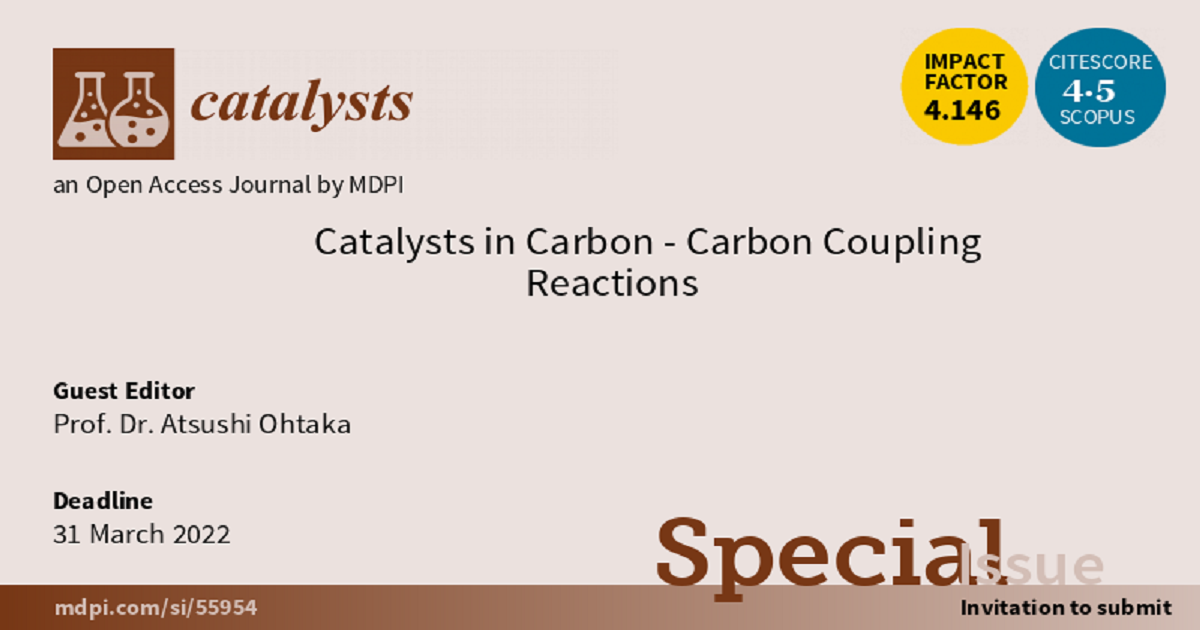Catalysts in Carbon-Carbon Coupling Reactions
A special issue of Catalysts (ISSN 2073-4344). This special issue belongs to the section "Catalysis in Organic and Polymer Chemistry".
Deadline for manuscript submissions: closed (31 March 2022) | Viewed by 10807

Special Issue Editor
Interests: metal nanoparticles; catalytic reactions in water; homogeneous catalysts; heterogeneous catalysts; green chemistry; reaction mechanism; surface reactivity
Special Issues, Collections and Topics in MDPI journals
Special Issue Information
Catalysis is an important area of synthetic chemistry and can be used to perform classical reactions under milder conditions with dramatically enhanced yields in shorter reaction times. The carbon–carbon bond forms the basic skeleton of an organic compound, and the carbon–carbon bond formation reaction is considered to be the most important reaction in organic synthesis. Among the diverse range of transformations, transition-metal-catalyzed cross-coupling reactions for carbon–carbon bond construction remain indispensable tools.
The present Special Issue focuses on recent research in carbon–carbon coupling reactions. Research topics may include (but are not restricted to): transition-metal-catalyzed reactions; asymmetric reactions; metal-nanoparticle-catalyzed reactions; C-heteroatom functionalization; C–H functionalization; and reaction mechanisms.
We welcome both original research papers and review articles for possible publication in this Special Issue.
Prof. Atsushi Ohtaka
Guest Editor
Manuscript Submission Information
Manuscripts should be submitted online at www.mdpi.com by registering and logging in to this website. Once you are registered, click here to go to the submission form. Manuscripts can be submitted until the deadline. All submissions that pass pre-check are peer-reviewed. Accepted papers will be published continuously in the journal (as soon as accepted) and will be listed together on the special issue website. Research articles, review articles as well as short communications are invited. For planned papers, a title and short abstract (about 100 words) can be sent to the Editorial Office for announcement on this website.
Submitted manuscripts should not have been published previously, nor be under consideration for publication elsewhere (except conference proceedings papers). All manuscripts are thoroughly refereed through a single-blind peer-review process. A guide for authors and other relevant information for submission of manuscripts is available on the Instructions for Authors page. Catalysts is an international peer-reviewed open access monthly journal published by MDPI.
Please visit the Instructions for Authors page before submitting a manuscript. The Article Processing Charge (APC) for publication in this open access journal is 2200 CHF (Swiss Francs). Submitted papers should be well formatted and use good English. Authors may use MDPI's English editing service prior to publication or during author revisions.
Keywords
- transition metal catalyst
- asymmetric catalyst
- metal nanoparticles
- homogeneous catalyst
- heterogeneous catalyst
- reaction mechanism
Benefits of Publishing in a Special Issue
- Ease of navigation: Grouping papers by topic helps scholars navigate broad scope journals more efficiently.
- Greater discoverability: Special Issues support the reach and impact of scientific research. Articles in Special Issues are more discoverable and cited more frequently.
- Expansion of research network: Special Issues facilitate connections among authors, fostering scientific collaborations.
- External promotion: Articles in Special Issues are often promoted through the journal's social media, increasing their visibility.
- e-Book format: Special Issues with more than 10 articles can be published as dedicated e-books, ensuring wide and rapid dissemination.
Further information on MDPI's Special Issue polices can be found here.





